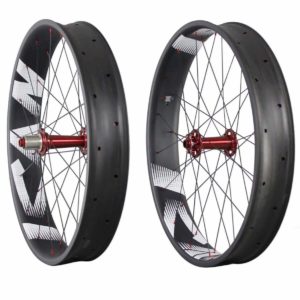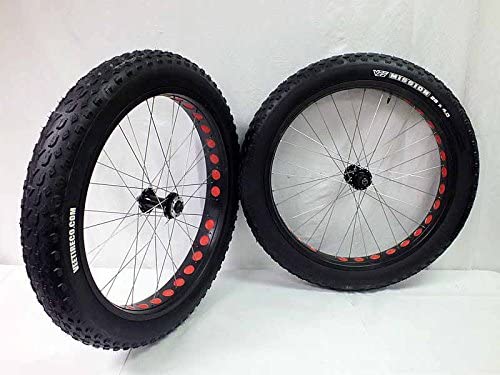What makes a bike a fat bike? When looking at just the geometry, it is hard to distinguish a fat bike from a mountain bike. However, it is those wheels that are the defining feature.
Most people are only looking at the tires themselves, but what about the rims underneath? There are some basics to know about what type of rims a person should invest in, or if they are looking to upgrade what they currently have.
Rims need to be a certain size so that they can handle fat bike tires, or else the entire ride will be compromised.
The first part of this article is examining the common rim widths that are available for fat bike riders. After that, we take a closer look at tires, and just what type of setup might work best for individuals out there.
Having the right amount of knowledge on this topic can allow people to get the ride that makes the most sense for them.
A stock fat bike option might seem great, but it is built for general use. If a person is constantly riding on soft snow or sand, they may need to customize things a bit so that they get a better feel.
Fat Bike Wheel Width Options

Most people do not pay attention to rim width on a fat bike until they have to. Maybe they need to replace a wheel, or they are looking to make an upgrade.
However, there are some categories for rim widths, which will allow people to make smart decisions overall. These are the main categories for rim width options for fat bikes.
40-50 mm Width
Technically speaking, these rims are not true fat bike size. They are still viewed in much the same way though, which is why they are put on this list.
People who want to have the lightest wheel possible and keep things as cheap as they can get a lot of use out of tires like these. The rim width will do a pretty good job of holding different types of tires.
It is surprising to some that they can get all the way up to 4-inch wide fat tire on a rim like this without anything being compromised.
Most of the time, people are going to stay right around 3 inches wide, or maybe a little bit bigger.
The reason why a lot of riders like this option is because they are trying to get wheels in a weight range that makes sense for them.
Maybe they want the weight benefits of a carbon fat bike rim, but they do not want to spend that type of money to get there. Going with a smaller width will help simulate at least the weight part of it.
While there could be some people trying to go even wider than 4 inches, it is not recommended. A person can put himself at a pretty big risk if they go in this direction. It is a lot like trying to cut corners, and it is not going to be beneficial in the end.
65 mm Width
Fat bike riders looking for an all-year-round option will really like the 65 mm width for fat bike rims. They are still going to be lightweight since they are not particularly bulky, and they provide quite a few other benefits as well.
For example, riders will notice that they can really start to lean into the corners when they are out on the trail, and they will also do a good job of floating.
About the only trouble that a person finds themselves in when riding 65 mm width is if they go into a lot of snow or a lot of sand.
It is not going to be able to handle those deep and troublesome surfaces, and that person might have to hop off to get through. That is one of the more annoying things any rider has to deal with when they are out on their bike.
Riders can go all the way up to a 5-inch tire if they want to with a 65 mm width. These rims are going to hold up, and there will not be any issues whatsoever.
80 mm Width
Now the tire rim is starting to get a bit big overall. An 80 mm width for rims is mostly reserved for riders who spend the majority of their time in a decent amount of sand or snow.
However, instead of going all the way up to 100 mm width, they can still go a little smaller and have everything handled properly.
It is always enjoyable to experience floating on any fat bike. In fact, it makes the overall ride pretty enjoyable, and a person does not have to deal with some of the complications to come with a 100 mm rim.
The feels a little bit better, and it will handle all those tighter trails quite a bit better.
It is mostly recommended that if a person has no idea what rim width to get for a fat bike, they should just go ahead and order 80 mm.
It is a catchall option that might not be the best of anything, but it is a pretty good option for any type of riding. People getting acquainted with how fat biking works, in general, will eventually become smarter.
100 mm Width
There are technically fatter rims out there for fat bikes, but this is about as big as most will be able to find. The simplest way to put it is that these rims are going to make a huge wheel for people who want to tackle any type of terrain whatsoever.
It is very easy to roll over just about anything on the trail, and that is one of the more satisfying feelings for some fat bike riders out there.
Not only that but being able to float in deep sand or even deep snow is a pretty outstanding feeling overall.
Traction with the 100 mm width is definitely something that attracts fat bike riders as well. If they want to make sure that they are not slipping around, the rim essentially flats out the tire when installed.
That means that more of the knobs on the tire is going to make contact with the ground, and there will be fewer options to slip around.
It is not all positives with the 100 mm width rim. For example, those who are in a bit of a tough situation will find it difficult to maneuver the bike as much as they would like.
It increases wheel resistance for sure, and it is not recommended to go on flat surfaces for long. It actually has a lot of challenges when on flat surfaces, which can be frustrating for any type of rider out there who has to spend a little bit of time not on an ideal surface.
Weight will also be one reason people will think about going elsewhere if they do not need all the benefits. These are the heaviest rims, and if the fat bike is heavy already, this could make it pretty tough to move around.
The weight penalty might not seem like much, but it starts to weigh on a person if they are going a long ride.
What to Keep In Mind Before Purchasing Fat Bike Rims

There are some fat bikes that will accept any type of rim width, but that is not always the case. Before making a purchase and then figuring out that they can’t work, make sure to do a little bit of research first.
Frame Limitations
There are some frames that will simply not allow a person to put on big rims. A 5-inch tire that is on 80 mm rims can sometimes be too much for some frames out there. Moving up to 100 mm is going to make the tire impossible to use at all.
Take some measurements and also eyeball things to make sure that something too big is not going to cause serious problems.
If the tire can’t rotate the proper way, what use does it have?
Too Much Weight
Anyone complaining about the weight of their bike already should not go for a bigger rim. While there could be some tradeoffs, it is ultimately going to be a pretty heavy situation for riders trying to move around.
Most fat bike riders are trying to remove weight, not add more to the mix.
Pricing
Not all rims are created equally, but the wider the rim, usually the more expensive they are. This can be frustrating for those people out there who have already spent a lot of money, and are considering doing some type of upgrade.
On the other hand, if bigger rims were already only lightly considered, it might not make much sense to spend extra money on something that might not bring huge amounts of benefits.
Picking The Right Fat Bike Tire For The Rims

Now that all the choices for fat bike rim options have been covered, it is time to think about tires. Everyone has different preferences, but there are a few things to keep in mind when looking for fat bike tires.
Diameter
Most of the older fat bike models that originally came out were 26 inches. Newer models jumped up to 27.5 inches, and there are even bigger ones that go up to 29 inches but those don’t really apply to Fat Bikes.
Most of it comes down to personal preference, as there are pros and cons for both. Generally speaking, if a person is already pleased with the current tires they have, they should stick with the same diameter.
Width
Tire width is something that directly correlates with rim width. It is common for first-time buyers to look for the widest tires possible to have the best amount of grip.
It also makes it better to go over rough surfaces like sand and snow, but it weighs a lot of riders down in many instances. There is also a bit of drag that is frustrating to deal with as well.
Only go for really wide fat bike tires if it is still relatively easy to pedal. Those who are smaller and just getting into fat biking might find it to be too difficult to power through with 5-inch tires.
They still feel like the fat bike is working if they slim down a bit, but they can maneuver just a little bit easier.
Tread
Fat bike tires are always running on thick knobs. With a knob, there is more area for contact, which means more grip on any type of surface.
It is true the fat bikes will struggle a bit on flatter surfaces, as they will not be able to dig in and really take advantage. However, for surfaces that people can cut through, this almost works the same way as spikes.
Brand
Several different fat bike tire brands have shown the world that they are very committed to making quality products.
Companies such as Maxxis, 45NRTH, and Surly are all ones to look out for. They not only offer affordable options that anyone can invest in, but they have some more expensive options for those who are really looking to step their game up.
Cheaper brands might exist, but most people are going to offer something that has a lot of good reviews. Since the fat bike industry is still growing, some of the upstart companies are not exactly playing by the rules.
They might appear to be flashy and show shoppers something that seems amazing, but it ends up being a bit of a dud.
Why Research Is Important When Shopping For Rims And Tires Sizes For Fat Bikes
At the end of the day, rims and tires need to be able to complement each other on a fat bike for everything to work as smoothly as possible.
Doing research beforehand will allow people to have a pretty good understanding of what they are able to change to if they want.
Getting a specific rim size does not necessarily mean that a person is stuck getting only a certain type of fat bike tire, but there will be some limitations overall.
As the sport continues to evolve, more and more people are really getting into all of the benefits of having some flexibility in finding quality wheel setups. By knowing a little bit more about rims and tires, the customization options are endless.

